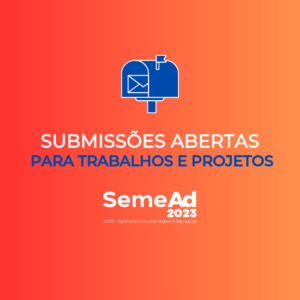Rules for Submission
- Sapiens – “Sessões de aprimoramento de artigos científicos para publicação” The submission of papers can only be done online.
- • Paper submission is free. However, if the paper is accepted for presentation at SemeAd, one of the authors must register as a conference participant. The registration fee for the event will be announced on 9/12, at the beginning of the registration period.
• The works must be unpublished.
• Works in progress are accepted that have already been presented at conferences other than SemeAd but have not been submitted and/or published in scientific journals.
• Papers can be submitted in one of four (4) ways and in the format of an academic article: (1) theoretical, papers aimed at reviewing, discussing, and developing theories on a given topic; (2) theoretical-empirical, works anchored in a theoretical problem (gap or contradiction in the theory) and that carry out empirical research using inductive logic (propositions) or deductive logic (hypotheses), applying qualitative or quantitative methods. Proposes a breakthrough in theory; (3) applied articles, works that employ theoretical models to reveal knowledge about organizations or groups of organizations (sectors or networks) or develop and/or test management models for organizations; and (4) teaching cases, works with educational objectives that focus on organizational situations or problems, developed as classroom activities.
• Papers can be submitted in Portuguese or English.
• The works cannot contain any identification or indication of authorship in the “property” field or in the body of the work.
• Papers must be submitted in PDF format files.
• Each work can have a maximum of five (5) authors.
• Each author can submit up to three (3) works between the modalities of theoretical articles, applied articles, and teaching cases and one (1) thesis project for the activity of the Doctoral Consortium.
• Authors must register in the SemeAd system. For registration, authors must have the CPF number of each of the Brazilian authors in hand. For foreign authors, there is a specific procedure.
• Changes in the authors’ data (inclusion, exclusion, and change in the order of authorship) can only be made until the submission deadline.
• The author responsible for the submission must indicate the co-authorship of the other authors. After completing the submission process, co-authors will receive an email to confirm co-authorship. Authors who do not confirm their co-authorship in the system will not be listed in the annals of the event.
Paper Categories:
Theoretical Articles: works aimed at reviewing, discussing, and developing theories, whether or not the result of systematic literature reviews.
Formatting the paper:
- Paper format: A4;
- Font: Times New Roman/size 12;
- Spacing: single, with the text arranged in one column;
- Alignment: justified;
- Margins: upper: 3 cm; lower: 2 cm; left: 3 cm; right: 2 cm;
- Pagination: insert page number at the bottom right hand side;
- Titles in upper case letters and subtitles in lower case letters;
- File format: PDF;
- The paper may have a maximum of 16 pages, including the text itself, illustrations, and bibliographical references;
- The text should start with the title, followed by the introduction. We suggest the authors prepare an extended abstract in a separate document and copy and paste each item in the specific field when submitting;
- Notes: these should not be placed in footnotes, but instead included as notes at the end of the text.
- The bibliographical references should be cited throughout the text according to the (author-date) system and presented in alphabetical order at the end of the paper, according to the APA or ABNT/NBR-6023 standards.
Suggested structure of the paper:
- Introduction: Research Problem and Objective
- Theoretical Framework
- Discussion
- Conclusion/Contribution
- Bibliographical References
Structured Abstract (submission page):
When submitting an article, on the paper submission page itself (stage 1), the structured abstract should be completed, including:
- Title (maximum of 190 characters);
- Keywords (3 words);
- Introduction (maximum of 600 characters);
- Research Problem and Objective (maximum of 600 characters);
- Theoretical Framework (maximum of 600 characters);
- Discussion (maximum of 600 characters);
- Conclusion (maximum of 600 characters);
- Contribution/Impact (maximum of 600 characters);
- Bibliographical References (maximum of 600 characters).
The paper can be sent to Sapiens in parallel – Sessions of Improving Scientific Studies.
Papers that do not comply with the formatting rules will not be accepted.
Paper format:
Theoretical-Empirical Articles: are anchored in theoretical problems (gaps or contradictions in the theory) and, based on these, using inductive (propositions) or deductive (hypothesis) logic, conducts empirical research applying qualitative or quantitative methods. It proposes an advance in theory.
Paper format:
- Paper format: A4;
- Font: Times New Roman/size 12;
- Spacing: single, with the text arranged in one column;
- Alignment: justified;
- Margins: upper: 3 cm; lower: 2 cm; left: 3 cm; right: 2 cm;
- Pagination: insert page number at the bottom right hand side;
- Titles in upper case letters and subtitles in lower case letters;
- File format: PDF;
- The paper may have a maximum of 16 pages, including the text itself, illustrations, and bibliographical references;
- The text should start with the title, followed by the introduction. We suggest the authors prepare an extended abstract in a separate document and copy and paste each item in the specific field when submitting;
- Notes: these should not be placed in footnotes, but instead included as notes at the end of the text.
- The bibliographical references should be cited throughout the text according to the (author-date) system and presented in alphabetical order at the end of the paper, according to the APA or ABNT/NBR-6023 standards.
Suggested structure of the paper:
- Introduction: Research Problem and Objective
- Theoretical Framework
- Methodology
- Results Analysis
- Conclusion/Contribution
- Bibliographical References
Structured Abstract (submission page):
When submitting the article, on the paper submission page itself (stage 1), the structured abstract should be completed, including:
- Title (maximum of 190 characters);
- Keywords (3 words);
- Introduction (maximum of 600 characters);
- Research Problem and Objective (maximum of 600 characters);
- Theoretical Framework (maximum of 600 characters);
- Methodology (maximum of 600 characters);
- Results Analysis (maximum of 600 characters);
- Conclusion (maximum of 600 characters);
- Contribution/Impact (maximum of 600 characters);
- Bibliographical References (maximum of 600 characters).
The paper can be sent to Sapiens in parallel. – <a href=”https://semead.com.br/26/sapiens-sessoes-de-aprimoramento-de-estudos-cientificos/?lang=en”Sessions of Improving Scientific Studies.
Papers that do not comply with the formatting rules will not be accepted.
Applied Articles: employ theoretical models to reveal knowledge about organizations or groups of organizations (sectors or networks), develop and/or test management models for organizations.
Paper format:
- Paper format: A4;
- Font: Times New Roman/size 12;
- Spacing: single, with the text arranged in one column;
- Alignment: justified;
- Margins: upper: 3 cm; lower: 2 cm; left: 3 cm; right: 2 cm;
- Pagination: insert page number at the bottom right hand side;
- Titles in upper case letters and subtitles in lower case letters;
- File format: PDF;
- The paper may have a maximum of 15 pages, including the text itself, illustrations, and bibliographical references;
- The text should start with the title, followed by the introduction. We suggest the authors prepare an extended abstract in a separate document and copy and paste each item in the specific field when submitting;
- Notes: these should not be placed in footnotes, but instead included as notes at the end of the text.
- The bibliographical references should be cited throughout the text according to the (author-date) system and presented in alphabetical order at the end of the paper, according to the APA or ABNT/NBR-6023 standards.
Suggested structure of the paper:
- Introduction
- Investigated Context;
- Diagnosis of the Situation-Problem;
- Proposed Intervention: mechanisms adopted to solve the problem;
- Results Obtained: objective description of the results obtained in the organization, also highlighting circumstantial factors that may have affected this result beyond the intervention.
- Technological-Social Contribution.
Structured Abstract (submission page):
When submitting the article, on the paper submission page itself (stage 1), the structured abstract should be completed, including:
- Title (maximum of 190 characters);
- Keywords (3 words);
- Introduction (maximum of 600 characters);
- Investigated Context (maximum of 600 characters);
- Diagnosis of the Situation-Problem (maximum of 600 characters);
- Proposed Intervention (maximum of 600 characters);
- Results Obtained (maximum of 600 characters);
- Technological-Social Contribution (maximum of 600 characters).
More information (Article: Protocol for Elaborating Technical Production Reports).
Papers that do not comply with the formatting rules will not be accepted.
Teaching Cases: this type of work is exclusively intended for the Teaching Cases area.
Paper format:
- Paper format: A4;
- Font: Times New Roman/size 12;
- Spacing: single, with the text arranged in one column;
- Alignment: justified;
- Margins: upper: 3 cm; lower: 2 cm; left: 3 cm; right: 2 cm;
- Pagination: insert page number at the bottom right hand side;
- Titles in upper case letters and subtitles in lower case letters;
- File format: PDF;
- The paper may have a maximum of 15 pages, including the text itself, illustrations, and bibliographical references;
- The text should start with the title, followed by the introduction. We suggest the authors prepare an extended abstract in a separate document and copy and paste each item in the specific field when submitting;
- The bibliographical references should be cited throughout the text according to the (author-date) system and presented in alphabetical order at the end of the work, according to the APA or ABNT/NBR-6023 standards.
Suggested structure of the paper:
Teaching cases should be composed of two parts: the case itself and the teaching notes.
- The case itself
- Introduction
- The case: portray the real story
- References
- Teaching notes
- Teaching objective
- Sources and collection methods
- Relationships with the objectives of a course or discipline
- Disciplines suggested for use of the case
- Possible tasks to propose to the students
- Possible organization of the class for use of the case
- Bibliography suggestions
Structured Abstract (submission page):
- Title (maximum of 190 characters);
- Keywords (3 words);
- The case (maximum of 600 characters);
- Teaching objective (maximum of 600 characters);
- Source and collection methods (maximum of 600 characters);
- Disciplines suggested for use of the case (maximum of 600 characters);
- Bibliography suggestions (maximum of 600 characters).
More Information: (Example of Teaching Case)
Papers that do not comply with the formatting rules will not be accepted.
- Only allowed submissions in English
- Attention, editors require writing consistent with the standard norms of the English language and good scientific writing practices.
- Articles submitted with an option for Top Journals, respecting the rules above, will be evaluated normally in SemeAd and in other fast-track options even if they exceed the limit of 16 pages (up to 24 pages)



